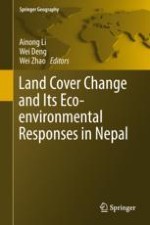Abstract
This chapter explores the historical processes of land cover change based on the review of past documents as well measuring the change between 1954 and 2015 in the Chure–Tarai area using published maps from 1954, 1979, 1994 and satellite based land cover maps of 2015. Deforestation and reclamation of cultivable waste land in the arable lowlands, for the purpose of resettlement through processes of land grants, installing feudal institutions to collect revenues and cover territorial administration and various policy incentives to attract hill people and Indian immigrants to expand settlements and agricultural expanse, all represent the historical processes of land cover change until 1950. The end of the Rana regime, through establishment of democracy, brought reforms in land tenure and abolished anti-peasantry feelings, which consequently attracted hill people to settle in the lowlands of Tarai, Bhawar, and Duns. Following from the eradication of malaria in the 1950s and 1960s, planned resettlement programs and the implementation of development projects attracted people from food-deficit conditions in the hills to the lowlands, causing a large-scale change in the land cover as well as the cultural landscape. Time series land cover maps revealed the predominance of forest in all physiographic units except Tarai in 1954. Forest cover began to decline in the later decades in all physiographic units at the gain of cultivated land. Forest coverage in the hill slopes, inner river valleys, and Duns and Bhawar represented 92, 72, 48, and 79% of the total area in 1954, which reduced to 89, 43, 36, and 64% in 1979. Forest cover in Tarai reduced from 30 to 15% by 1979 over the same period. It further reduced to 85, 24, 29, and 58% respectively in 1994. Only 10% of the area in Tarai was under forest. Compared to 1994, forest coverage decreased to 82, 20, 28, and 54% in the hill slopes, inner river valleys, and Duns and Bhawar respectively, in 2015. It has virtually remained the same in Tarai over the last two decades. Hence the rate of forest decline over the last six decades was high in arable areas of river valleys and Bhawar. The highest rate of deforestation was observed in the west, compared to the east and central part of the Chure–Tarai region. The proportion of shrub/grass areas increased notably in the Chure hill slopes, inner river valleys, and Duns. This implies a degradation of forest, which is a threat to the ecology and stability of such fragile slopes and terrain. Although conversion from forest to cultivated land is a general trend in recent decades, reclamation of forest, shrub, or grass from abandoned or damaged cultivated areas represents quite a significant characteristic of the internal dynamics of land cover change. This is attributable to abandonment of cultivated terraces on marginal hill slopes and damage caused by floods, channel shifts, and bank erosion on low land. Apart from the historical drivers, contemporary drivers of land cover change are demographics, development and increasing physical access and mobility, and urbanization. Illegal settlements on public forest land or encroachment on the land mainly by the landless, poverty stricken, and disaster hit people, as well as political instabilities, a continued dependency on forest resources, over grazing, forest fires, landslides, erosion, and floods are also recognized drivers of change. Forest and land resource degradation, loss or threat to biodiversity, increased landslide and flood disaster, the disruption of river and wetland ecology, and the depletion of ground water resources represent noticeable evidence of the negative consequences of an environment associated with the processes of land cover change.
